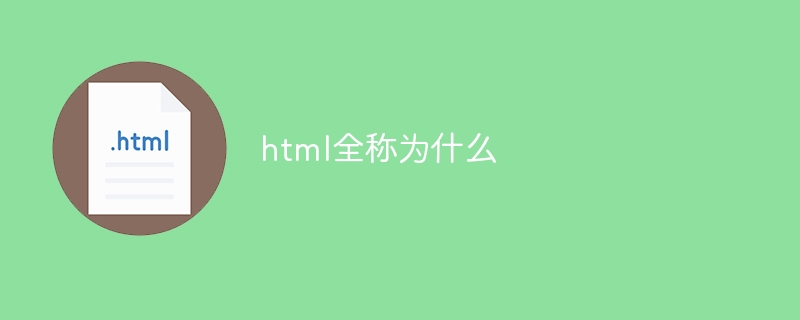What is the full name of html?
HTML stands for HyperText Markup Language. It is the cornerstone language for web page production and is used to define the structure and content of web pages. HTML implements hypertext functionality through hyperlinks, allowing users to browse information on the Internet. HTML tags tell the browser how to display content, such as headings or italicized text. HTML files include a document type declaration, HTML tags, header and body tags. HTML is used to create web pages, defining their structure, how content is displayed, and how elements interact.

HTML full name HyperText Markup Language
HTML is the cornerstone language for web page production. It defines the structure and structure of web pages. content. Its full name is HyperText Markup Language, literally translated as "Hypertext Markup Language".
Hypertext
Hypertext refers to a form of text that can be linked to each other. For example, text in a web page can be linked to other web pages or documents. HTML implements hypertext functionality through hyperlinks ( tags), allowing users to easily browse and access information on the Internet.
Markup language
Markup language is a language that uses tags to define the structure of content. HTML tags are words surrounded by angle brackets that tell the browser how to display content. For example, the
tag represents first-level headings, while the tag represents italicized text.
Composition of HTML
HTML file consists of the following parts:
- Document type declaration (DOCTYPE): Specify the HTML version.
- Tag: Define the beginning and end of the HTML document.
- Tag: Contains document metadata such as title, character set, and style sheet.
- Tag: Contains the visible content of the web page, such as text, images, and tables.
The role of HTML
HTML is used to create web pages. It defines:
- The structure and layout of the web page (title , paragraphs, lists, etc.)
- The display method of the content (font, size, color, etc.)
- The interactive relationship between web page elements (hyperlinks, forms, etc.)
HTML is a simple, easy-to-learn language and a basic knowledge that anyone who wants to create web pages can master.
The above is the detailed content of What is the full name of html?. For more information, please follow other related articles on the PHP Chinese website!

Hot AI Tools

Undresser.AI Undress
AI-powered app for creating realistic nude photos

AI Clothes Remover
Online AI tool for removing clothes from photos.

Undress AI Tool
Undress images for free

Clothoff.io
AI clothes remover

AI Hentai Generator
Generate AI Hentai for free.

Hot Article

Hot Tools

Notepad++7.3.1
Easy-to-use and free code editor

SublimeText3 Chinese version
Chinese version, very easy to use

Zend Studio 13.0.1
Powerful PHP integrated development environment

Dreamweaver CS6
Visual web development tools

SublimeText3 Mac version
God-level code editing software (SublimeText3)

Hot Topics
 1384
1384
 52
52
 What is the purpose of the <progress> element?
Mar 21, 2025 pm 12:34 PM
What is the purpose of the <progress> element?
Mar 21, 2025 pm 12:34 PM
The article discusses the HTML <progress> element, its purpose, styling, and differences from the <meter> element. The main focus is on using <progress> for task completion and <meter> for stati
 What is the purpose of the <datalist> element?
Mar 21, 2025 pm 12:33 PM
What is the purpose of the <datalist> element?
Mar 21, 2025 pm 12:33 PM
The article discusses the HTML <datalist> element, which enhances forms by providing autocomplete suggestions, improving user experience and reducing errors.Character count: 159
 What is the purpose of the <meter> element?
Mar 21, 2025 pm 12:35 PM
What is the purpose of the <meter> element?
Mar 21, 2025 pm 12:35 PM
The article discusses the HTML <meter> element, used for displaying scalar or fractional values within a range, and its common applications in web development. It differentiates <meter> from <progress> and ex
 What is the viewport meta tag? Why is it important for responsive design?
Mar 20, 2025 pm 05:56 PM
What is the viewport meta tag? Why is it important for responsive design?
Mar 20, 2025 pm 05:56 PM
The article discusses the viewport meta tag, essential for responsive web design on mobile devices. It explains how proper use ensures optimal content scaling and user interaction, while misuse can lead to design and accessibility issues.
 Is HTML easy to learn for beginners?
Apr 07, 2025 am 12:11 AM
Is HTML easy to learn for beginners?
Apr 07, 2025 am 12:11 AM
HTML is suitable for beginners because it is simple and easy to learn and can quickly see results. 1) The learning curve of HTML is smooth and easy to get started. 2) Just master the basic tags to start creating web pages. 3) High flexibility and can be used in combination with CSS and JavaScript. 4) Rich learning resources and modern tools support the learning process.
 What is the purpose of the <iframe> tag? What are the security considerations when using it?
Mar 20, 2025 pm 06:05 PM
What is the purpose of the <iframe> tag? What are the security considerations when using it?
Mar 20, 2025 pm 06:05 PM
The article discusses the <iframe> tag's purpose in embedding external content into webpages, its common uses, security risks, and alternatives like object tags and APIs.
 The Roles of HTML, CSS, and JavaScript: Core Responsibilities
Apr 08, 2025 pm 07:05 PM
The Roles of HTML, CSS, and JavaScript: Core Responsibilities
Apr 08, 2025 pm 07:05 PM
HTML defines the web structure, CSS is responsible for style and layout, and JavaScript gives dynamic interaction. The three perform their duties in web development and jointly build a colorful website.
 What is an example of a starting tag in HTML?
Apr 06, 2025 am 12:04 AM
What is an example of a starting tag in HTML?
Apr 06, 2025 am 12:04 AM
AnexampleofastartingtaginHTMLis,whichbeginsaparagraph.StartingtagsareessentialinHTMLastheyinitiateelements,definetheirtypes,andarecrucialforstructuringwebpagesandconstructingtheDOM.




